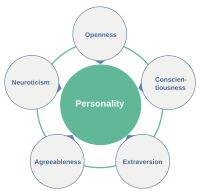
Photo from wikipedia
The fading affect bias (FAB) occurs when unpleasant affect fades faster than pleasant affect. To detect mechanisms that influence the FAB in the context of death, we measured neuroticism, depression,… Click to show full abstract
The fading affect bias (FAB) occurs when unpleasant affect fades faster than pleasant affect. To detect mechanisms that influence the FAB in the context of death, we measured neuroticism, depression, anxiety, negative religious coping, death attitudes, and complicated grief as potential predictors of FAB for unpleasant/death and pleasant events at 2 points in time. The FAB was robust across older and newer events, which supported the mobilization-minimization hypothesis. Unexpectedly, complicated grief positively predicted FAB, and death avoidant attitudes moderated this relation, such that the Initial Event Affect by Grief interaction was only significant at the highest 3 quintiles of death avoidant attitudes. These results were likely due to moderate grief ratings, which were, along with avoidant death attitudes, related to healthy outcomes in past research. These results implicate complicated grief and death avoidant attitudes as resiliency mechanisms that are mobilized during bereavement to minimize its unpleasant effects.
Journal Title: International Journal of Environmental Research and Public Health
Year Published: 2018
Link to full text (if available)
Share on Social Media: Sign Up to like & get
recommendations!